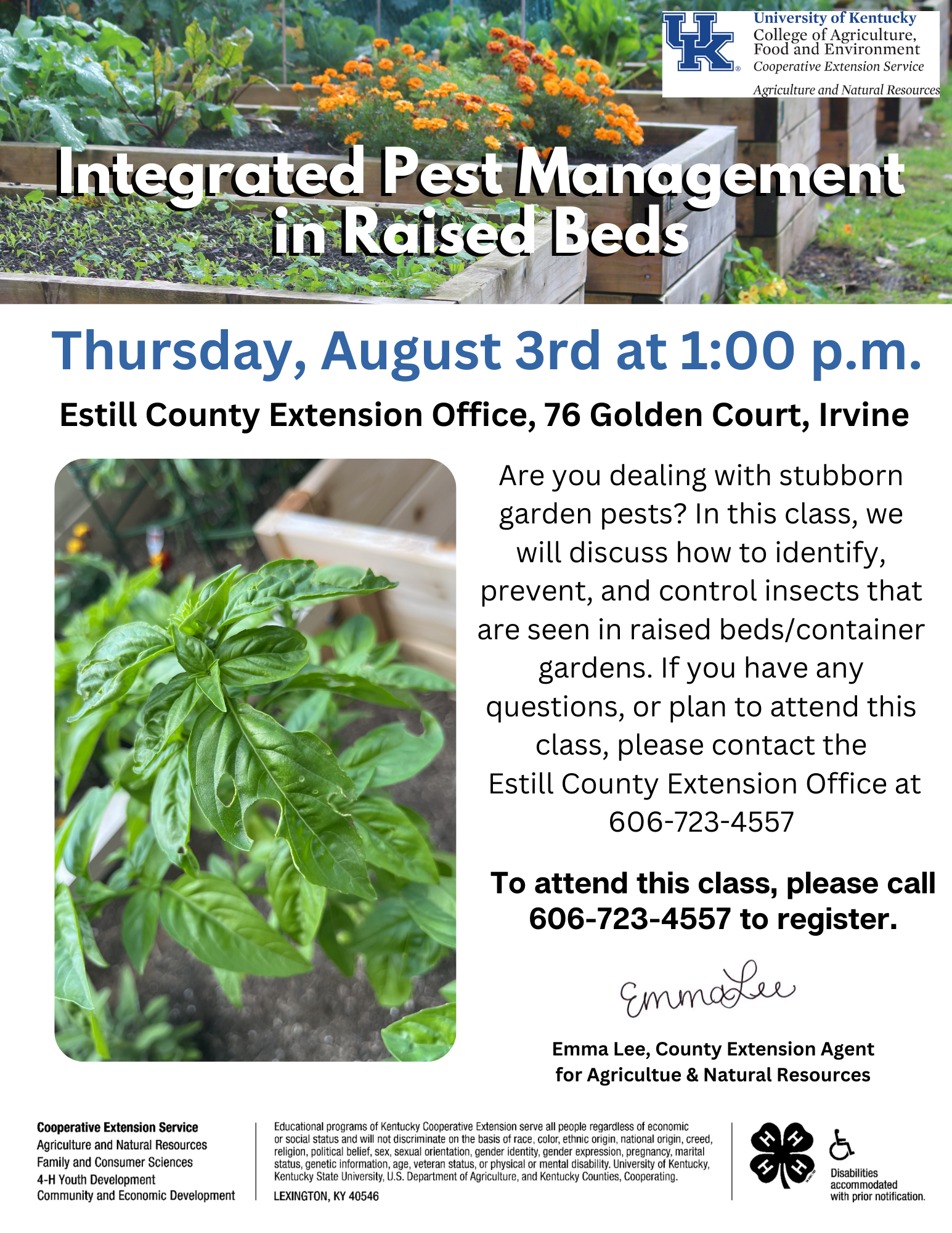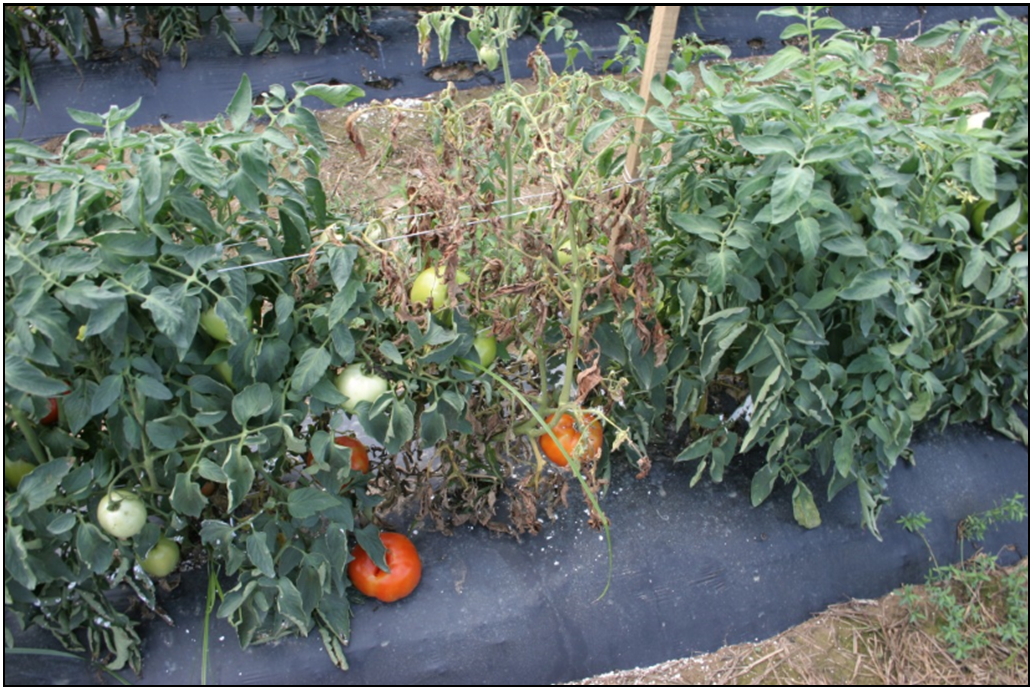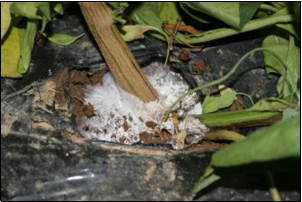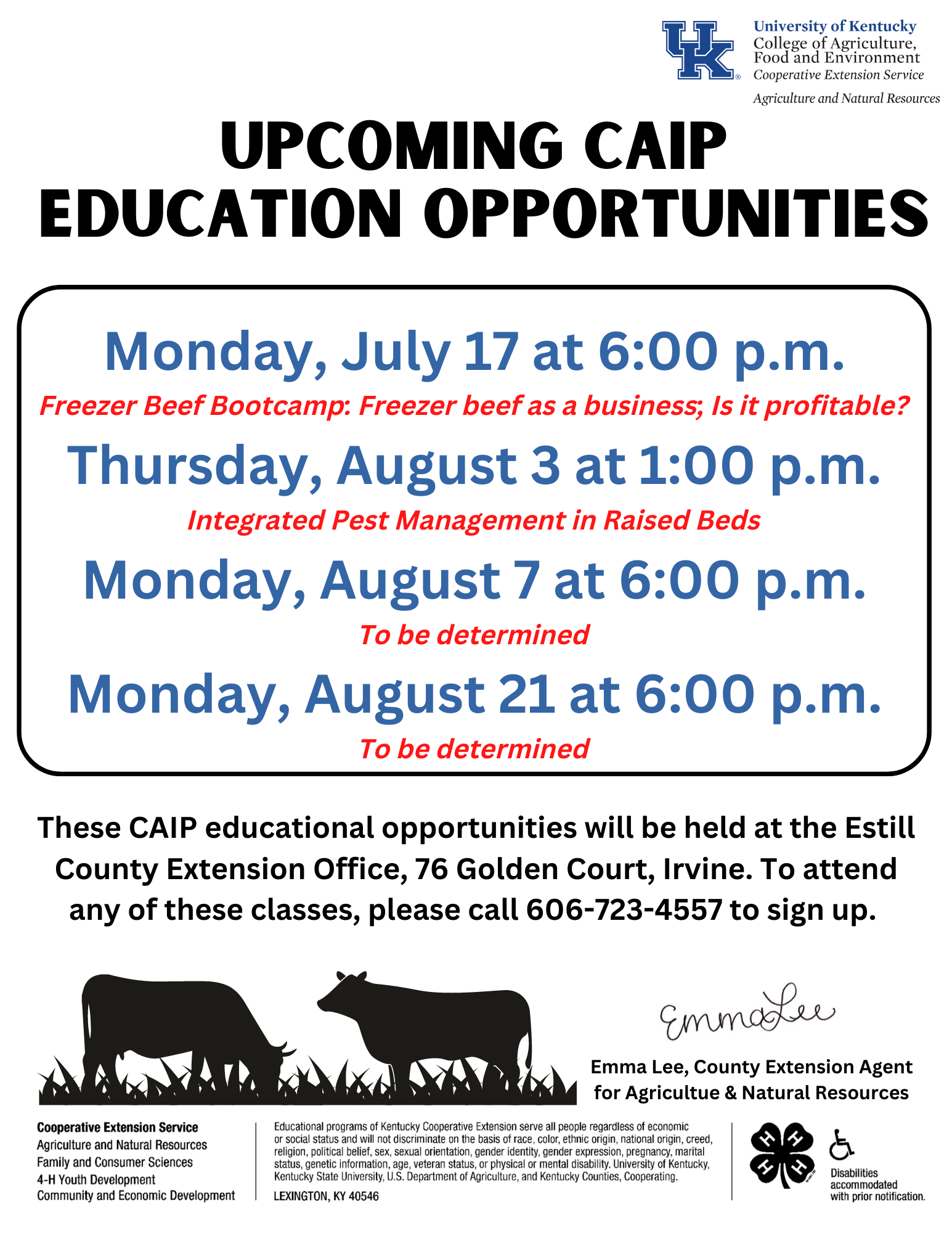Estill County Farm Scoop
July 2023 Edition
Agriculture & Natural ResourcesView Newsletter
Share this Newsletter
Additional Newsletters
Preview This Newsletter
Estill County Farm Scoop
Agriculture & Natural Resources
July/August 2023
Hello everyone! As summer is in full swing, be sure you are scouting for pests in your garden at least once per week. The recent rain patterns can cause disease to show up very quickly, as well as new pests. Feel free to call or email me and we can discuss a plan for pest management.
One common pest that I have already seen multiple times this summer on vegetables is the Fall Armyworm. This pest is at it’s peak population in July and August so it is very likely you will see one yourself. Larvae vary from light tan to nearly black with three thin light yellow lines down the back. There is a wider dark stripe and a wavy yellow red splotched stripe on each side. They resemble both armyworms and corn earworms but fall armyworms have a prominent white inverted Y mark on the front of the head. Survey 20 plants from each location, initiating your count randomly. Small larvae will cause "window pane" damage. Record damage, number and size of larvae. Collect specimens for verification. Feeding by small armyworms resembles European corn borer damage. More information can be found at https://ipm.ca.uky.edu/content/fall-armyworm.
These next few months I will have multiple classes available to earn your CAIP education credit. Keep an eye out for those dates and put them on your calendar if you are needing to attend!
As always, feel free to call or email me with any questions you may have. I am here to help!
Emma Lee
County Extension Agent for Agriculture and Natural Resources

Southern blight of vegetables
Southern blight, also known as basal stem rot, is a common disease of vegetables, as well as other agronomic and specialty crops. While this fungal disease is capable of infecting a wide range of hosts, the most common vegetables affected include beans, cabbages, cucumbers, peppers, and tomatoes. Plants infected with the southern blight pathogen ultimately die, resulting in yield losses. Use of cultural practices and fungicides can limit damage.
Southern Blight Facts
- Symptoms are often first observed as the wilting of foliage. Over time, leaves yellow and stems and branches turn brown (Figure 1). Decay of stems and crowns ultimately results in rapid plant death. Infected stems and crowns may exhibit a fuzzy, white growth (mycelia), which is the fungal body of the casual organism. Small, fungal reproductive structures (sclerotia) develop in mycelia. Sclerotia are initially white, but later become tan to brown in color (Figure 2).

Figure 1: Plants affected by southern blight exhibit leaf yellowing and rapid blighting of stems and branches (Photo: Kenny Seebold, UK). - Pathogen structures overwinter in plant debris and infested soil as sclerotia. These structures may survive for up to 5 years.
- Disease development is favored by high temperatures and periods of high humidity.Southern blight is caused by the fungal pathogen, Athelia rolfsii (formerly Sclerotium rolfsii).

Figure 2: White mycelia may develop on infected plant parts. Within the mycelium, small round sclerotia develop. (Photo: Kenny Seebold, UK).
Management
- Avoid planting in fields with a history of southern blight.
- Deep till fields and high tunnels with a history of disease.
- Solarize soil in fields and high tunnels.
- Rotate away from susceptible crops.
- Remove and destroy infected plants or plant parts.
- Clean and sanitize tools, pots, and equipment.
- Avoid moving infested soil to clean beds or gardens.
- Remove and destroy plant debris at the end of the season.
Commercial growers can find information on fungicides in the Vegetable Production Guide for Commercial Growers (ID-36) and the Southeast U.S. Vegetable Crop Handbook. Homeowners should consult Home Vegetable Gardening (ID-128) for fungicide information or contact a county Extension agent for additional information and recommendations regarding fungicides.
Additional Resources
- Southern Blight (PPFS-VG-16)
- IPM Scouting Guide for Common Problems of Cucurbit Crops in Kentucky (ID-91)
- IPM Scouting Guide for Common Problems of Solanaceous Crops in Kentucky (ID-172)
- Sustainable Disease Management of Cucurbit Crops in the Home Garden (PPFS-VG-19)
- Sustainable Disease Management of Solanaceous Crops in the Home Garden (PPFS-VG-21)
- Home Vegetable Gardening (ID-128)
- Vegetable Production Guide for Commercial Growers (ID-36)
By: Kim Leonberger, Plant Pathology Extension Associate and Nicole Gauthier, Extension Plant Pathologist
Harvesting blueberries and blackberries for full flavor
Source: John Strang, UK extension fruit and vegetable specialist
It’s almost summer, and that is prime harvest season for blueberries and blackberries, both of which have the potential to grow very well in Kentucky. Blueberries, which are native to North America, are ready to harvest from early June through early August. Blackberries are ready to harvest from mid-June to early October. These delicious fruits offer health benefits, but best of all, they capture the essence of summer in their sweetness.
Blueberries can be excellent choices for both home and commercial growing. They have the advantage of being as long-lived as fruit trees, with few pests or diseases. They also have a late blossom time, so frost rarely causes damage on well-chosen sites. Blackberries also have a long fruit-bearing life and will produce for a decade or longer in Kentucky.
Blueberries require an acidic soil, which means that most soils in Kentucky will need to be amended to properly suit their needs. They also require a high organic material content, so peat moss should be mixed with the soil at the time of planting. Do not substitute with other materials. Irrigation is necessary during the summer because blueberries have a shallow, limited root system. Insufficient irrigation can compromise both this year’s and next year’s crops.
Blackberries need to be pruned, fertilized and irrigated. Pruning varies, depending on the type of bramble; for specific information on the proper pruning for your blackberry canes, see the University of Kentucky’s publication, “Growing Blackberries and Raspberries in Kentucky.” It’s available online at http://www.ca.uky.edu/agc/pubs/ho/ho15/ho15.pdf or by contacting your local office of the UK Cooperative Extension Service.
Blueberries in a cluster do not ripen at the same time, and only fully ripe berries should be picked. Fruit need at least one to two days after turning blue to develop full flavor and can be left on the bush for up to 10 days without a loss in size. Flavor does not improve once the fruit is picked; consequently, blueberries should be left on the bush for as long as possible to develop sweetness and flavor.
For best results at harvest, pick carefully, rolling blueberries from the cluster with the thumb into the palm of the hand. Handle as little as possible to avoid rubbing off the bloom (the light waxy finish on the skin) and reduce bruising. Harvest only when berries are dry. Refrigerate promptly to slow ripening and decay.
Blackberries picked for commercial sale are picked “firm ripe,” but home growers have the luxury of picking soft, fully ripe and juicy fruit. Pick fruit twice a week, and during hot, rainy weeks, every other day. Harvest after the morning dew has dried. Pick carefully to avoid bruising the fruit, and, as with blueberries, refrigerate quickly to limit fruit rot. The sweetest, best tasting fruit is produced during dry, sunny weather when nights are cooler.
For more information, see UK’s publications on growing blueberries and blackberries available online at http://www.ca.uky.edu/agc/pubs/ho/ho60/HO60.PDF and http://www.ca.uky.edu/agc/pubs/ho/ho15/ho15.pdf, or contact the Estill County Cooperative Extension Service.
Support your local farmers market
Source: Mark Williams, Horticulture professor and department chair
Growing season is in full swing, and your local farmers market has the freshest produce, meats and value-added products around.
When you purchase from a farmers market vendor, most of which are small, family operations, it reduces the time it takes for food to travel from a large, commercial farm to a grocery store and onto your dinner plate. This means that local growers can wait to pick the produce and deliver it to you when it is at the peak of freshness. At the same time, you are reducing fuel emissions and transportation costs the growers would have to pay to sell their products outside the county. Many times, farmers markets are closer to your home than a grocery store, so shopping at the markets could cut down on your fuel costs too.
Buying from farmers markets is good for the local economy and one way to preserve agriculture in rural communities. Farmers market purchases keep your money in your community. It allows growers with small-to-medium-sized operations to receive a fair price for their products without having to compete against large commercial growers. With an established, local market to sell their products, new growers have a viable entry into agriculture and an improved chance at success.
With much of the farmers markets products being fresh fruits and vegetables, you also have the opportunity to add more nutrition, vitamins and minerals to your family’s plates. This can lead to healthier diets.
Buying from a local vendor can help you connect to the person who is growing your food. It can be a great lesson for your children on where food comes from. Over the course of the season, many repeat farmers market customers develop personal connections and friendships with vendors.
The Estill County Farmers’ Market is held Tuesday evenings from 6:00-8:00 p.m. at 184 Broadway Street, Irvine (Library parking lot) and Saturdays from 9:00 a.m.-1:00 p.m. at 1505 Richmond Road (beside Mill Creek Market). For more information about your local farmers market find them on Facebook at https://www.facebook.com/estillcountyfarmersmarket, or contact the Estill County office of the University of Kentucky Cooperative Extension Service.


